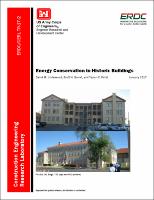Please use this identifier to cite or link to this item:
https://hdl.handle.net/11681/29353Full metadata record
| DC Field | Value | Language |
|---|---|---|
| dc.contributor.author | Underwood, David Michael | - |
| dc.contributor.author | Garret, Brett N. | - |
| dc.contributor.author | Patel, Tapan C. | - |
| dc.date.accessioned | 2018-09-19T14:59:12Z | - |
| dc.date.available | 2018-09-19T14:59:12Z | - |
| dc.date.issued | 2017-01 | - |
| dc.identifier.govdoc | ERDC/CERL TR-17-2 | - |
| dc.identifier.uri | http://hdl.handle.net/11681/29353 | - |
| dc.identifier.uri | http://dx.doi.org/10.21079/11681/29353 | - |
| dc.description | Technical Report | - |
| dc.description.abstract | This work reviewed the U.S. Department of Defense (DoD) stock of buildings that has either been declared historical or deemed eligible for historic building status. Six buildings at Fort Sill, OK, that represent commonly found buildings were selected to be studied for potential Energy Efficiency Measures (EEMs). Three historic buildings at Fort Bliss were also included in the analysis. Computer models of the buildings energy use were developed and used to estimate the potential energy savings of the various EEMs. Costs for the EEMs were estimated, simple paybacks were calculated, and the results were extrapolated to the 15 U.S. climate zones and summarized. A list of EEMs that may be applicable to historic buildings and a general guide to their effectiveness in various climates was developed. | en_US |
| dc.description.sponsorship | United States. Office of the Assistant Secretary of Defense for Energy, Installations, and Environment. | en_US |
| dc.description.sponsorship | Legacy Resource Management Program (U.S.) | - |
| dc.description.tableofcontents | Abstract .......................................................................................................................................................... ii Executive Summary ..................................................................................................................................... iii Tables and Figures .........................................................................................................................................x Preface ..........................................................................................................................................................xiv 1 Introduction ............................................................................................................................................ 1 1.1 Background ..................................................................................................................... 1 1.2 Objectives ........................................................................................................................ 1 1.3 Approach ......................................................................................................................... 2 2 Energy Terms .......................................................................................................................................... 3 2.1 Heating and cooling degree days ................................................................................... 3 2.2 Climate zones.................................................................................................................. 3 2.3 eQUEST – The Quick Energy Simulation Tool ................................................................ 5 2.3.1 Overview ................................................................................................................................... 5 2.3.2 Inputs ........................................................................................................................................ 5 2.3.3 Outputs ..................................................................................................................................... 6 2.4 Btus, Therms, and MMBtus ........................................................................................... 6 2.5 Watts, Kilowatts (kW), and Kilowatt-Hour (kWh) ........................................................... 6 2.6 Footcandles and lumens ................................................................................................ 6 2.7 Economizer...................................................................................................................... 7 3 DoD Stock of Historic and Potentially Historic Buildings ............................................................. 8 3.1 Most prevalent building types ........................................................................................ 9 3.1.1 Barracks.................................................................................................................................... 9 3.1.2 Hangars .................................................................................................................................. 10 3.1.3 Administrative facilities .......................................................................................................... 10 3.1.4 Summary ................................................................................................................................ 10 3.2 Selection of an Army installation ................................................................................. 13 4 Fort Sill and Buildings Modeled ....................................................................................................... 15 4.1 Building descriptions .................................................................................................... 15 4.1.1 Bldg. 441 ................................................................................................................................ 15 4.1.2 Bldg. 462 ................................................................................................................................ 17 4.1.3 Bldg. 463 ................................................................................................................................ 18 4.1.4 Bldg. 750 ................................................................................................................................ 20 4.1.5 Bldg. 1803 .............................................................................................................................. 21 4.1.6 Bldg. 3419 .............................................................................................................................. 22 4.2 Approach to finding and evaluating ECMs .................................................................. 23 4.2.1 Bldg. 441 energy use – “as is” .............................................................................................. 24 4.2.2 Bldg. 462 energy use – “as is” .............................................................................................. 27 4.2.3 Bldg. 463 energy use – “as is” .............................................................................................. 27 4.2.4 Bldg. 750 energy use – “as is” .............................................................................................. 27 4.2.5 Bldg. 1803 energy use – “as is” ............................................................................................ 27 4.2.6 Bldg. 3419 energy use – “as is” ............................................................................................ 28 4.3 The building model results – “Original State” ............................................................. 28 4.3.1 Bldg. 441 energy use – “Original State” ............................................................................... 28 4.3.2 Bldg. 462 energy use – “Original State” ............................................................................... 28 4.3.3 Bldg. 463 energy use – “Original State” ............................................................................... 28 4.3.4 Bldg. 750 energy use – “Original State” ............................................................................... 29 4.3.5 Bldg. 1803 energy use – “Original State” ............................................................................. 29 4.3.6 Bldg. 3419 energy use – “Original State” ............................................................................. 29 4.4 Energy efficiency measures ......................................................................................... 29 4.4.1 Bldg. 441 EEM Descriptions, implementation costs and savings by climate zone ............ 30 4.4.2 Bldg. 462 EEM savings by climate zone ............................................................................... 36 4.4.3 Bldg. 463 EEM savings by climate zone ............................................................................... 43 4.4.4 Bldg. 750 EEM savings by climate zone ............................................................................... 49 4.4.5 Bldg. 1803 EEM savings by climate zone ............................................................................. 56 4.4.6 Bldg. 3419 EEM savings by climate zone ............................................................................. 63 5 Fort Bliss and Buildings Modeled .................................................................................................... 71 5.1 Buildings modeled ........................................................................................................ 71 5.1.1 Bldg. 1 ..................................................................................................................................... 71 5.1.2 Bldg. 115 ................................................................................................................................ 72 5.1.3 Bldg. 1103 .............................................................................................................................. 74 5.2 The building model results – “as is” ............................................................................ 75 5.2.1 Bldg. 1 energy use – “as is” ................................................................................................... 75 5.2.2 Bldg. 115 energy use – “as is” .............................................................................................. 75 5.2.3 Bldg. 1103 energy use – “as is” ............................................................................................ 75 5.3 EEMs considered .......................................................................................................... 76 5.3.1 Bldg. 1 EEM savings by climate zone .................................................................................... 76 5.3.2 Bldg. 115 EEM savings by climate zone ............................................................................... 82 5.3.3 Bldg. 1103 EEM savings by climate zone ............................................................................. 87 6 Historic Building Energy Savings Spreadsheet Tool .................................................................... 94 7 Summary and Conclusions ............................................................................................................... 95 References ................................................................................................................................................ 101 Acronyms and Abbreviations ................................................................................................................. 103 Report Documentation Page (SF 298) ................................................................................................ 105 | - |
| dc.format.extent | 125 pages / 4.93 Mb | - |
| dc.format.medium | PDF/A | - |
| dc.language.iso | en_US | en_US |
| dc.publisher | Construction Engineering Research Laboratory (U.S.) | en_US |
| dc.publisher | Engineer Research and Development Center (U.S.) | en_US |
| dc.relation.ispartofseries | Technical Report (Engineer Research and Development Center (U.S.)) ; no. ERDC/CERL TR-17-2 | - |
| dc.rights | Approved for Public Release; Distribution is Unlimited | - |
| dc.source | This Digital Resource was created in Microsoft Word and Adobe Acrobat | - |
| dc.subject | Energy consumption--Cost effectiveness | en_US |
| dc.subject | Historic buildings | en_US |
| dc.subject | Historic preservation | en_US |
| dc.subject | Buildings--Repair and reconstruction | en_US |
| dc.subject | Military bases | en_US |
| dc.title | Energy conservation in historic buildings | en_US |
| dc.type | Report | en_US |
| Appears in Collections: | Technical Report | |
Files in This Item:
| File | Description | Size | Format | |
|---|---|---|---|---|
| ERDC-CERL TR-17-2.pdf | 5.05 MB | Adobe PDF |  View/Open |